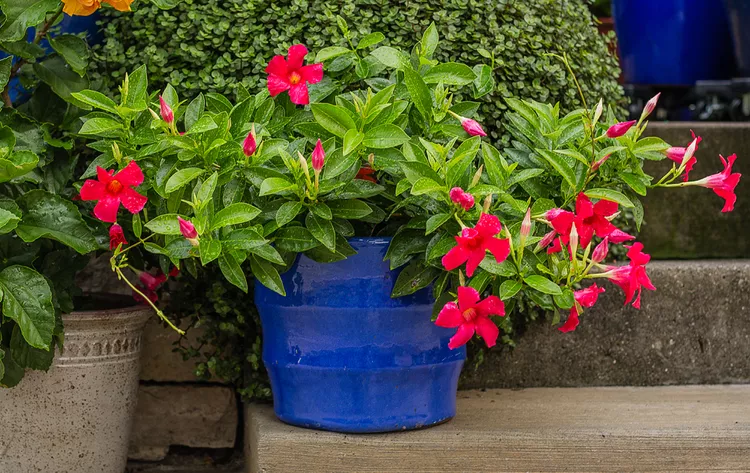Growing mandevillas as outdoor perennials is out of the question if you live where winters are cold, but growing them in containers for the summer is within reach for everyone. Whether you choose a vining or a mounding variety, mandevilla care in pots is easy enough when you know what these beautiful flowering plants require. Use the following tips to grow mandevilla plants in containers and you'll enjoy plenty of bright, tropical blooms.
Tips for Mandevilla Care in Pots
A little attention to soil, container selection, and location will keep your mandevilla blooming and beautiful.
1. Select a large container.
Mandevillas often come in plain black nursery pots. They might be potbound and need a new home for more than aesthetic reasons. When choosing a new container, consider the mature size of your mandevilla variety. A large plant needs a large pot; leaving your mandevilla in a small container stifles it. Larger pots also have more mass, saving tall climbing mandevillas from tipping over in a gust of wind.
While the standard advice for repotting a houseplant is to go up one size or an inch or two wider than the previous pot, it's better to choose a larger container for your mandevilla because it will quickly expand to use the space. Mandevillas do not like to be potbound, so give them room to grow—the plant above directly reflects the roots below.
2. Ensure the pot has good drainage.
Even though mandevillas are tropical plants that appreciate consistent moisture, they must have good drainage so the roots can breathe. Without adequate drainage, mandevillas are susceptible to root rot and other diseases.
Many store-purchased plastic pots have pre-formed drainage holes molded into the bottom, but they must be punched out. Some decorative ceramic pots don’t have drainage at all and are intended more as a cover than a container for a plant; the plant remains in a separate pot and is removed for excess water to be poured out. Make sure your mandevilla will have good drainage one way or another.
3. Use slightly sandy potting soil.
Mandevillas need rich, well-drained soil that is a bit sandy. While regular potting mix will work, a better composition is two parts potting mix, one part sand, and one part compost. Including the sand provides better drainage, and the humus in the compost holds nutrients and provides moisture control.
4. Water and fertilize regularly.
Mandevillas like moist soil, but it shouldn’t be soggy or consistently wet. Use your finger to test the soil, and water the plant when the soil feels dry an inch or two down. A thorough watering once or twice a week as needed is better than daily shallow applications.
To encourage blooms, fertilize when watering with a high-phosphorus fertilizer, like a 5-10-5 (the middle number is the phosphorus in the standard N-P-K fertilizer system). Fertilizing every two weeks during the summer is an important part of mandevilla care in pots since the plants can't access nutrients in the ground.
5. Give mandevillas something to climb.
Mandevilla varieties with a vining growth habit need something to climb. It’s easy to forget that the little trellis the plant came with isn’t sufficient for a vine that may grow 15 to 20 feet.
Provide a proper sturdy support or structure for your potted mandevilla to twine around, giving you the tropical, vertical color display they’re famous for. An arbor or trellis anchored to the deck or wall is a good choice, but mandevillas can climb stakes, mailbox posts, or anything else sturdy enough to support their weight. Ensure the structure is well-anchored to resist toppling in strong wind.
6. Plant in full or part sun.
Mandevillas grown outside in containers perform and flower best in full sun for most locations. Six hours or more per day is sufficient. For hot, southern climates with more intense rays, a location with shelter from the hottest afternoon sunshine is ideal.
Don’t be dismayed if your location is only partly sunny. While mandevillas do best in full sun, part sun is also acceptable, although the plant might grow a little slower and bloom a little less.
Using Mandevilla in Patio Garden Designs
Long, climbing vines covered in colorful flowers are the main reason to grow mandevillas. They provide a tropical feeling that can be complemented with hibiscus, papyrus, cordyline, bird of paradise, caladiums, and begonias. And mandevillas with a mounding habit are perfect for smaller spaces like balconies and patios where a larger plant would be out of place.
Giant planters filled with these warm-weather-loving plants can bring a playful island feel to a patio or other outdoor space, and they are tall enough to create a screening effect. If you have a pergola, set mandevillas to climb up the posts and along the top for a fantastic blooming display.




















